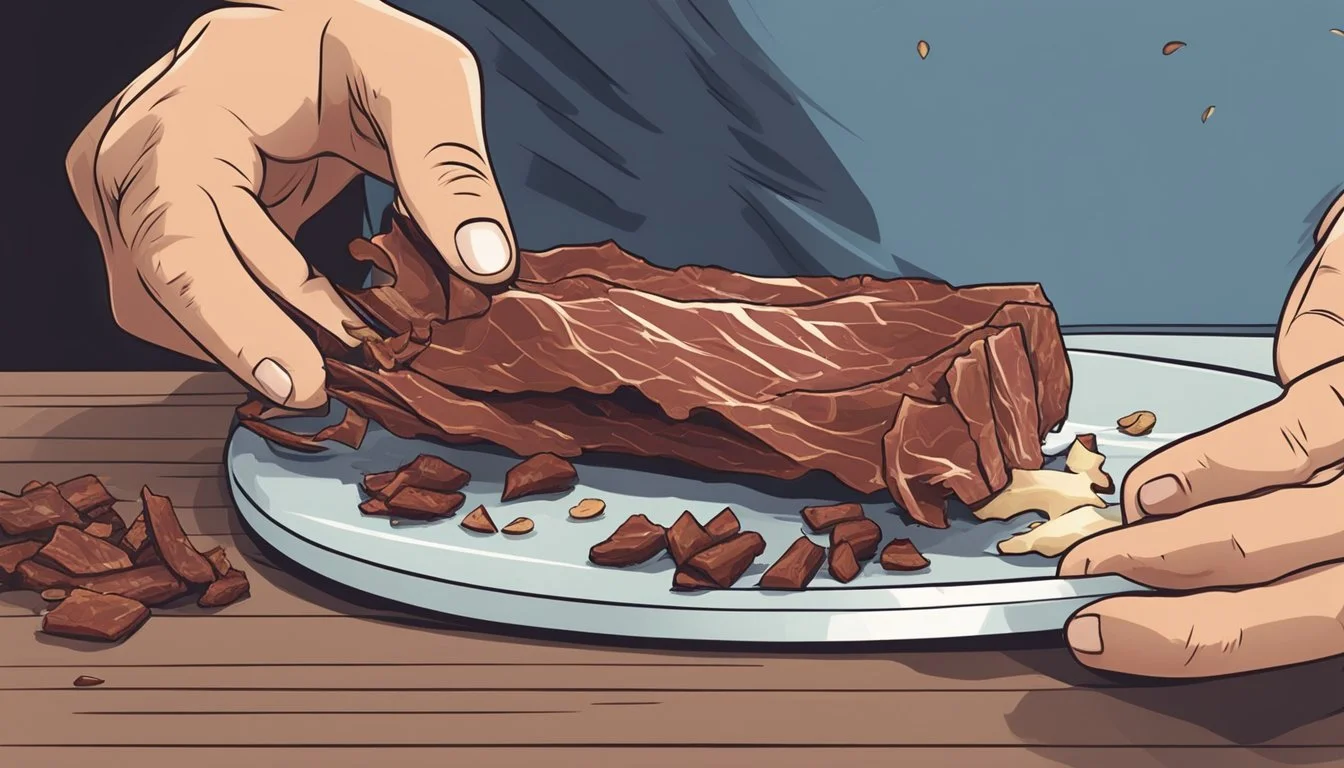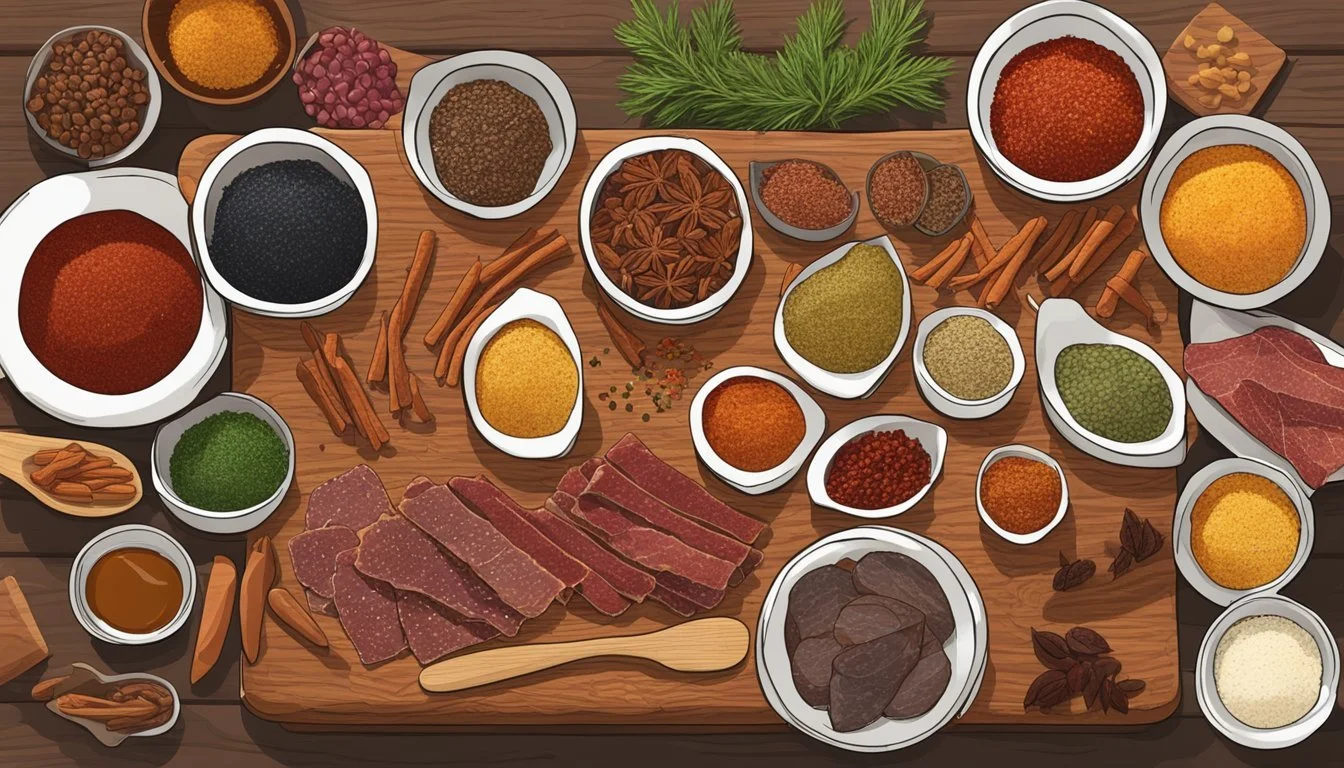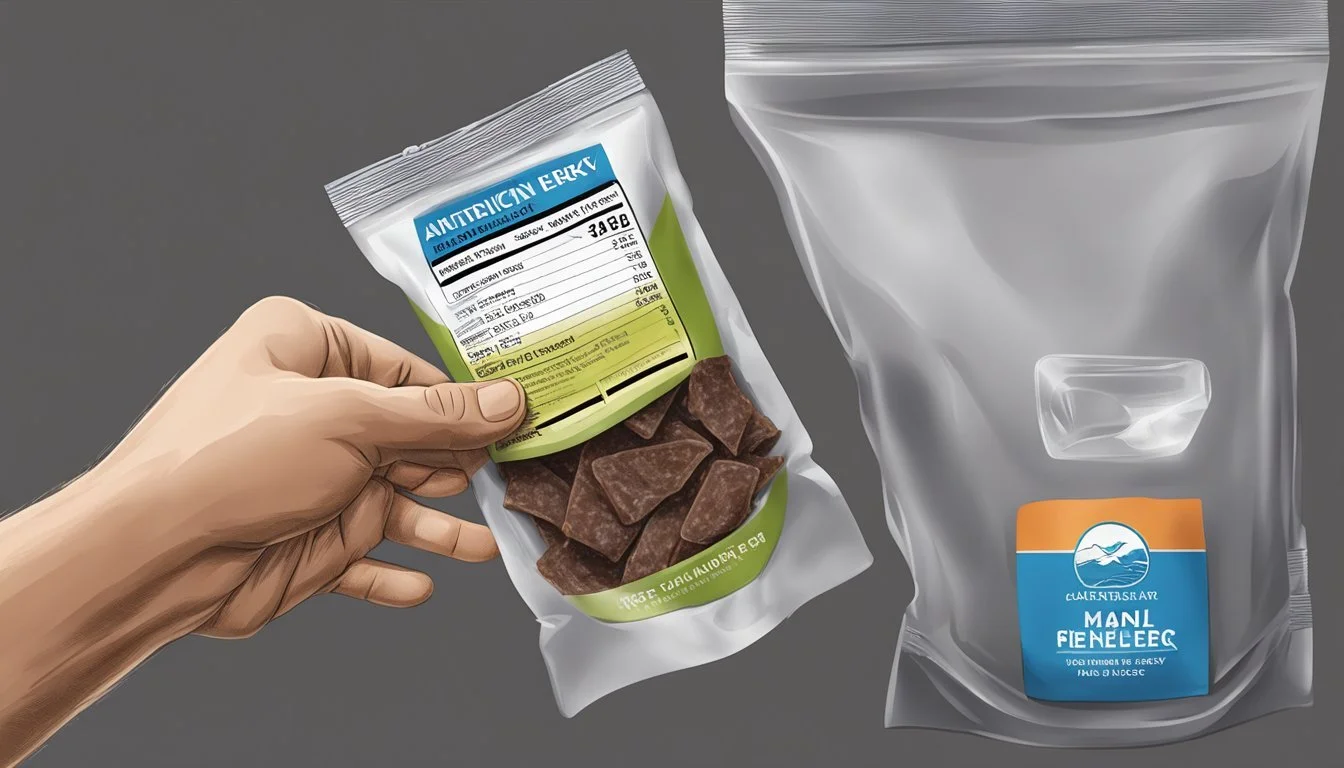How Do You Eat Jerky?
Tips for Enjoying This Savory Snack
Jerky, a seasoned and dried meat snack, has been a popular food for centuries, valued for both its flavor and convenience. Its roots can be traced back to ancient civilizations, where the necessity to preserve meat without refrigeration led to the creation of this enduring foodstuff. Today, jerky is often made from beef (how long does beef last?), but a variety of meats can be used, and its portability, long shelf life, and nutritional value keep it on the list of favored snacks (What wine goes well with snacks?). High in protein and low in fat, beef jerky serves as a healthy snack option for those seeking sustenance without the heft of fresh meat.
Eating jerky is straightforward, but enthusiasts argue there's a certain art to fully enjoy its qualities. Typically, it is consumed directly out of the packet, with consumers appreciating the lean meat that's been trimmed of fat and cut into pieces before being dried. This traditional preparation leads to a chewy texture that releases the flavors gradually as it is savored, allowing for appreciation of both the meat's natural flavors and the added seasonings.
The ways to incorporate jerky into a diet extend beyond snacking directly from the packet. Its versatility is showcased when it's used as a component in various dishes, bringing a rich, smoky essence to meals such as omelets, stews, baked potatoes, and even soups. The robust flavor of jerky can complement many recipes, ensuring that it adds a savory depth to both classic and innovative culinary creations.
What Is Jerky?
Jerky refers to lean cuts of meat that have been trimmed of fat, sliced, and then dried to prevent spoilage. This creates a lightweight, protein-rich food product that is both nutritious and durable.
Historical Background
Originally, the concept of jerky came from the need to preserve meat for long periods without refrigeration. The word "jerky" itself is derived from the Quechua word "ch'arki," which means "dried meat." Indigenous cultures, particularly in South America, would salt and dry slices of game or domesticated animals. Over time, this method spread globally and evolved, giving rise to variations like biltong in South Africa and pemmican in North America.
Types of Jerky
There are numerous varieties of jerky, with beef jerky being one of the most well-known. Other meats used include turkey, salmon, bison (What wine goes well with bison?), and even exotic meats like alligator. Jerky can be homemade or store-bought, with homemade beef jerky allowing for customization in flavor and texture. Each type offers unique taste profiles but generally follows the same process of drying seasoned meat.
Beef Jerky: Typically made from marinated beef strips.
Biltong: A form of dried, cured meat that originated in South Africa.
Pemmican: A mixture of dried meat, usually bison, and fat.
Turkey Jerky: A healthier, lower-fat alternative to beef jerky.
Jerky Nutritional Profiles
Jerky is valued for its high protein content, making it a filling and energy-boosting snack. Additionally, it can provide important nutrients like iron but is usually high in sodium. Store-bought jerky may also contain preservatives and flavor enhancers. Here's the general nutritional profile for beef jerky:
Calories: Around 116 per ounce
Protein: Approximately 9.4 grams
Fat: Generally 7.3 grams
Iron: Varies depending on meat type
Sodium: Can be significant due to the preservation process
Nutrient levels can vary, particularly between homemade and commercial products. Homemade jerky typically contains fewer additives and can be tailored to reduce sodium levels for a more health-conscious option.
Benefits of Eating Jerky
Jerky offers a blend of convenience and nutritious value that aligns well with an active lifestyle. By focusing on its portability and health aspects, individuals can enjoy this snack on various occasions without compromising on dietary goals.
Portability and Convenience
Jerky stands out for its portability, making it a go-to snack for those who are active and frequently on the move. It is especially popular among individuals who enjoy hiking or camping, as it does not require refrigeration and is lightweight. This feature allows for easy packing and transportation, ensuring a readily available source of nourishment without the burden of carrying heavier food items.
Healthy Aspects
When considering jerky as a healthy option, it's important to note its high protein content, which is essential for muscle repair and growth. One ounce of beef jerky typically provides around 9.4 grams of protein. Moreover, jerky can be a part of paleo-friendly diets, due to its minimal processing and absence of grains. When selecting jerky, opting for grass-fed beef is a wise choice as it's often more nutritious and may contain healthier fats compared to grain-fed counterparts. Additionally, many jerky products are gluten-free, catering to those with specific dietary restrictions. However, consumers should be mindful of the sodium content and look for brands that offer lower-sodium options to keep their snack both healthy and nutritious.
Making Your Own Jerky
Crafting homemade jerky offers a savory snack tailored to personal taste preferences, involving selecting an appropriate cut of meat, preparing it with a suitable technique, and choosing the right method for dehydration.
Choosing the Right Cut
When one opts for beef jerky, particular cuts are ideal due to their low fat content and robust flavor. Flank steak, top round, sirloin tip, and brisket are popular choices. They should trim any visible fat before and after dehydration, as fat does not dry out and can cause the jerky to spoil more quickly.
Flank Steak: Lean with bold flavor; slice against the grain.
Top Round: Economical, relatively tender; ideal for consistent texture.
Sirloin Tip: Less marbling, requires careful slicing for an even dry.
Brisket: Rich taste, demands meticulous fat trimming.
Preparation Techniques
To ensure evenly dried jerky, one must slice the meat uniformly. A common technique is to partially freeze the meat to facilitate easier cutting. Thickness can range from 1/8 inch to 1/4 inch. The meat then gets marinated in a concoction of choice—a crucial step for introducing flavors. Marinades often include a mix of soy sauce, Worcestershire sauce, black pepper, garlic, onion powder, and sometimes a sweetening agent like honey.
Wrap and Freeze: Wrap the beef in plastic and freeze for 1-2 hours.
Slice: Use a sharp knife and cut against the grain.
Marinate: Submerge the slices in the marinade for several hours to overnight.
Dehydration Methods
The critical stage for jerky making is dehydration which concentrates the meat’s flavor and preserves it by removing moisture. Here, a kitchen oven or a food dehydrator is used. If using an oven, it should be set to the lowest temperature, generally around 175°F, and the meat should be placed on wire racks for optimal air circulation.
Oven: Preheat to 175°F and arrange meat on wire racks, rotating pans as needed.
Dehydrator: Follow device instructions, typically dehydrate at 160°F.
Smoking: An alternative for those seeking a smoky flavor profile; it requires a smoker and longer dehydration time.
Meat is dried until it can bend without breaking and should typically have a leathery appearance. This process takes about 3-4 hours in an oven and can vary depending on the thickness of the slices and the method used.
Flavors and Seasonings
When it comes to eating jerky, the right combination of flavors and seasonings can elevate this snack from simply dried meat to a gourmet experience. The blend of spices and the marinating process are crucial for infusing jerky with its distinctive taste.
Traditional Spices
Garlic and black pepper are quintessential ingredients that provide a familiar and comforting flavor profile. They are often combined with brown sugar to balance the spices with sweetness, creating a classic jerky taste that appeals to a wide audience. Traditional marinades typically include Worcestershire sauce and soy sauce as liquid bases, which impart a deep umami flavor and the right amount of saltiness to the jerky.
Spices:
Garlic
Black pepper
Paprika
Marinade Components:
Worcestershire sauce
Soy sauce
Brown sugar
Olive oil (as a fat component)
The dry spices such as paprika add a layer of complexity, contributing a slight smokiness and a richness in color, enhancing the jerky's visual appeal.
Innovative Recipes
Innovative jerky recipes experiment with diverse flavor combinations, pushing beyond the traditional recipes. These may include an array of spices like chili powder or cayenne pepper for heat, cumin for earthiness, or even citrus zest for freshness. Marinades can be enriched with ingredients like olive oil to lend richness or by swapping regular sugar with alternatives like honey or maple syrup for a different kind of sweetness.
Spice Variations:
Chili powder (for heat)
Cumin (for earthiness)
Marinade Variations:
Alternative sweeteners (honey, maple syrup)
Olive oil (for a different fat profile)
These flavor innovations not only cater to individual preferences but also introduce new sensory experiences to the jerky, making it a versatile snack that never gets boring.
Enjoying Jerky
Jerky is a versatile snack that offers a rich tapestry of flavors and textures to be savored methodically. Here are insights into how one can optimize the consumption of jerky and explore complementary pairings with other foods.
Optimal Consumption
The optimal enjoyment of jerky comes from appreciating its flavor and texture. To best savor jerky:
Take smaller bites to fully appreciate the salty and savory notes.
Chew slowly, allowing the flavors to release gradually and the jerky to go from a moist consistency to a softer one.
Avoid overeating jerky; it's meant to be enjoyed in moderation to prevent feeling overstuffed.
Pairing with Other Foods
Jerky pairs well with a variety of other foods. The key is to balance the jerky's robust flavor with complementary tastes and textures:
Cheese: A slice of sharp cheese can enhance the jerky's savory aspect.
Nuts: For a satisfying crunch, nuts are a great side that don't overpower the jerky's taste.
Pickles and Vegetables: The acidity of pickles or the freshness of raw vegetables can cut through the jerky's saltiness.
Fruit: Pairing jerky with fruits can add a sweet counterpart to the meat's intenseness.
Salad: Tossing small jerky pieces into a salad provides a protein boost and an extra layer of flavor.
Soup: Adding jerky to soups can impart a smoky depth to the broth.
When experimenting with pairings, the goal should be to neither overshadow the jerky's flavor profile nor to choose accompaniments that are too mild to be noticed.
Storing Jerky
Proper storage is crucial in preserving the quality and extending the shelf life of both store-bought and homemade jerky. Attention to storage conditions and methods can greatly influence jerky's taste and safety for consumption.
Optimum Storage Conditions
To preserve jerky effectively, one should store it at room temperature in a cool, dry place such as a pantry or cupboard. Exposure to direct sunlight or heat sources must be avoided as they can accelerate the drying process, potentially altering the flavor and texture. The ideal storage temperature for jerky is between 40-70 degrees Fahrenheit.
Maximizing Shelf Life
Airtight Containers: An airtight container or resealable bag is essential to maximize the shelf life, providing a barrier against moisture and air which can lead to spoilage.
Refrigeration: While not always necessary, refrigerating jerky in an airtight container can further extend its shelf life.
Freezer: For long-term storage, freezing jerky is advisable. One can freeze the jerky for up to 6 months without significant changes in quality. However, it’s recommended to freeze a small quantity first to test for any alterations in flavor post-freezing.
By adhering to these guidelines, one can ensure that jerky remains fresh, tasty, and safe to eat for as long as possible.
Health Considerations
When eating jerky, it is important for individuals to consider the sodium content and the quality of ingredients as these factors substantially influence the snack's healthfulness.
Understanding Sodium Content
Most jerky, being a processed food, is high in sodium, which is used for preservation and flavor. Too much sodium in one's diet can lead to health issues such as hypertension. To manage sodium intake, one should look for jerky with less than 140 mg of sodium per ounce. This is considered to be a low sodium level according to dietary guidelines.
Selecting Quality Ingredients
The health benefits of jerky can also be affected by its ingredients, particularly the source of the meat. Grass-fed beef jerky typically boasts a more favorable nutritional profile, including healthier fats. Additionally, jerky made with minimal processing and without unnecessary additives generally provides better nutritional benefits. Seeking out products with a clear and straightforward list of ingredients can ensure the snack aligns with healthy eating practices.
Commercial Jerky Options
The commercial jerky market offers a vast selection, with products ranging from store-bought varieties to those found at your local gas station. Each brand has its own unique nutritional profile, catering to an array of dietary preferences and tastes.
Popular Brands
Jack Link's: A well-known name in the jerky industry, offering a variety of flavors and meat types.
Oberto: Provides classic jerky as well as more innovative options like trail mixes with jerky pieces.
Krave: Known for artisanal jerky with unique flavor profiles such as chili lime and black cherry barbecue.
Old Trapper: Offers large clear-view bags of jerky to showcase product quality and freshness.
These brands typically offer a range of beef jerky products, with some expanding into other meats like turkey and pork. Consumers often have a variety of flavor options, from traditional smoked to spicy or teriyaki.
Comparing Jerky Products
When comparing jerky products, consumers should consider:
Nutritional Profiles: Investigate the protein content, sodium levels, sugar, and presence of any artificial additives.
Price: Costs can vary significantly from one brand to another, with some premium products priced higher.
Availability: Some brands are easily found in supermarkets, convenience stores, and gas stations, while others may be more niche and available primarily online or in specialty stores.
Packaging: Resealable packaging is a common feature, which helps maintain freshness after opening.
A table comparing a few common nutritional profiles:
Brand Protein (g per serving) Sodium (mg per serving) Sugar (g per serving) Artifical Additives (Y/N) Jack Link's 11 590 3 N Oberto 12 470 1 N Krave 9 410 8 N Old Trapper 10 600 5 Y
This table only provides a snapshot of what to look for when comparing jerky products. One should also consider personal dietary needs and preferences when making a selection.








